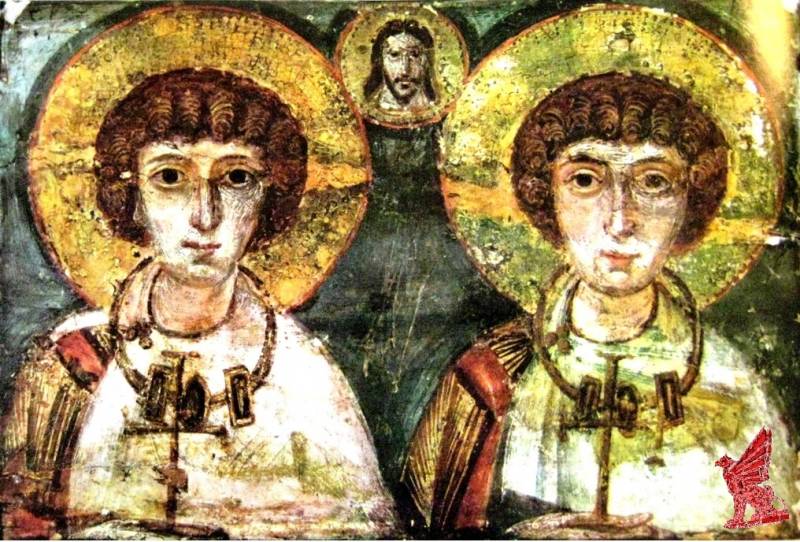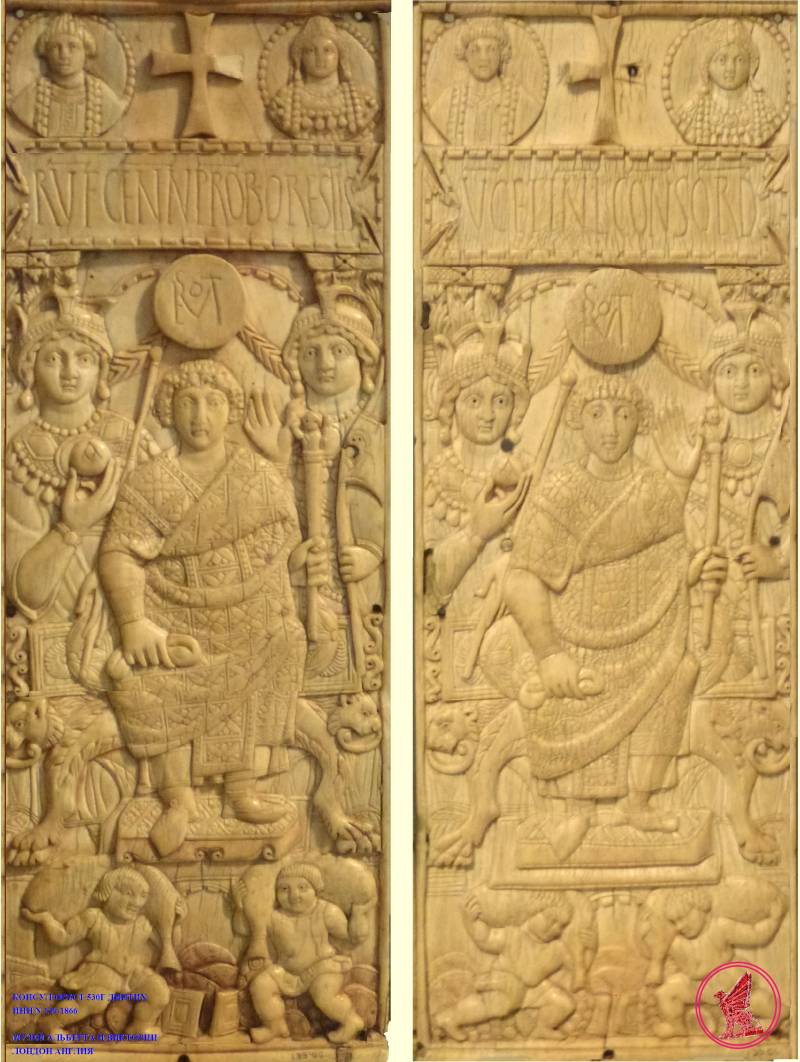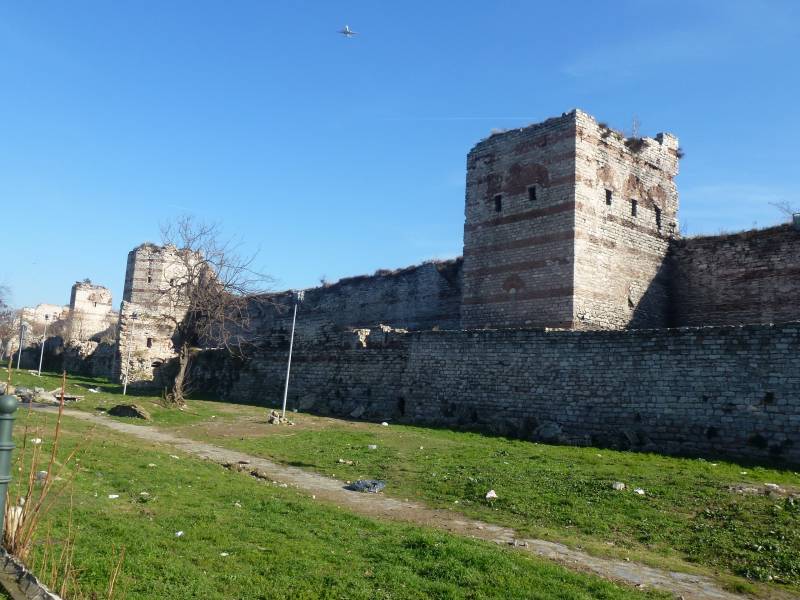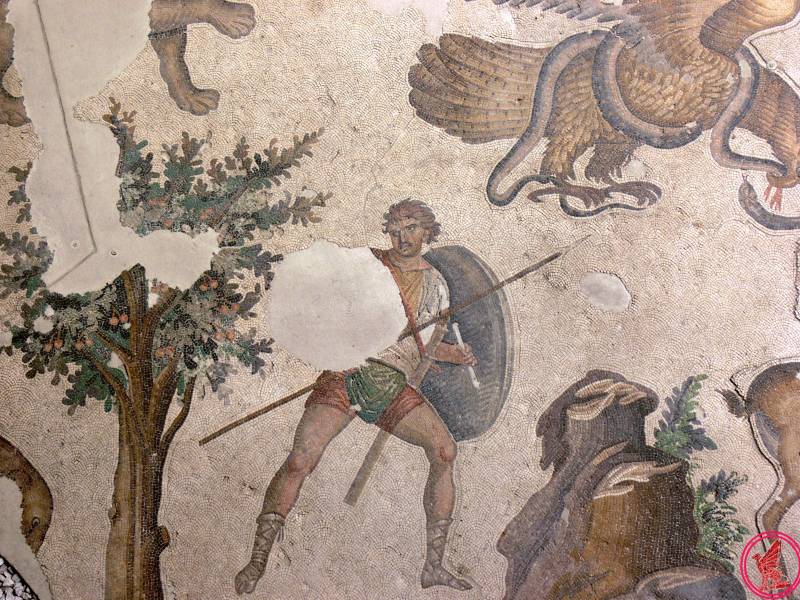Army of Byzantium VI. Supply and condition of the troops
An important component of the conduct of hostilities is the uninterrupted supply of the army with the necessary resources.
The army was supplied by means of money allowances to all categories of servicemen, by allocating land allotments to personnel and border servicemen, providing the army with weapons and the necessary resources for conducting combat operations.
1. Annona militatis - the allowance paid to the warriors included in the Catalogs (military lists). Payment was made on the basis of service life: the younger the call, the less payment. Only stratiots fell into this category.
2. Annona foederatica is the monetary allowance payable to federates. Money allowance was paid depending on the length of service.
3. Donative - the amount that was paid to each soldier upon assuming the throne of the emperor, and every five years thereafter.
4. The military estate for the successful provision of the service was endowed with land. The warriors, perhaps using their privileged state, or, perhaps because of ethnic psychology (the Germans), oppressed ordinary landowners and tenants. [Kulakovsky Y. History Byzantium (515-601gg). T. II. SPb., 2003. C.238-239.].
5. The children of the warriors were included in the catalog lists of the regiments by inheritance.
It can be assumed that during this period there was still a clear and well-thought-out supply system for the army, which reflected the legacy of the Roman Empire. In the country there were state workshops for the production of: weapons, equipment, uniforms and clothing for soldiers. Such workshops were located in different regions. In Egypt, there were weaving workshops, in Thrace - weapons, but especially many were in the capital. The equipment was stored in state arsenals. At the borders were located hospitals.
The warrior was supposed to appear in the service with small arms: wear a tokofaretrar the same thing as “being under the gun”, “being in the service”. Riders had to take care of their own equipment and weapons, while horse equipment was supplied by the state. Recruits were supplied with clothes, which was extremely important in the conditions of material scarcity of that period. So, Herman, reproaching the rebel soldiers Stotsy, tells them that before the military service they wore torn clothes. Belisarius in the army in the East, found in Mesopotamia soldiers who "were mostly bare and unarmed." The unification of clothes in the army was such that during the battle of Herman with deserters Stoetz in Africa, the warriors of the opposing sides were no different either in equipment or in clothing.
Food (from one boiler), as well as living (in one tent), was carried out within the framework of the contour line - the lower military cell.
In the campaigns, the army was supplied with bread or grain, wine and other products, feed for horses. The supply of the army at the expense of the enemy, i.e. by robbery, remained topical. The army was accompanied by a huge train, where there was all the property of soldiers and commanders. In the wagon train there were waists, wives of warriors and commanders, merchants, heteras, servants and slaves. "The Byzantine army, - according to the apt expression of F. Cardini, - ... was a very peculiar combination of the army with a caravan and a" commercial enterprise. " [Cardini F. Origins of Medieval Knighthood. M., 1987. C.255.]. From the middle of the 6th century, army financing became sporadic. Since the “regiments” did not campaign in full force, but were hired, the actual issue of cash security for the stratiots arose. Going to the second company against ready to Italy, Belisarius, due to political intrigues, assumed the obligation to maintain the troops at his own expense, as a result he was inactive for five years and compensated for his financial losses by collecting tax arrears from the population of devastated Italy . In the previous campaign, Belisarius bought equipment to shield bearers and spearmen at his own expense.
Delays in the payment of salaries were common phenomena, which caused soldiers' insurrections and usurpations. Attempts to save on defense, in modern terms, led to the fact that without funding remained entire units:
1. Under the pretext of peace with Persia under Emperor Justinian I, the Limits did not receive a salary of five years, which led to a sharp decrease in the number of border troops and, as a result, Arab invasions of unprotected lands.
2. Justinian I stopped the tradition of the Donative. But this action did not cause a reaction in the troops, possibly due to the huge rotation due to wars.
3. During the war with Khosrov I in 540, after the surrender of the acropolis of Veroi (Halleb), the soldiers released went massively to the Persians, arguing that the treasury had not paid them for a long time.
4. In 588, the emperor Mauritius issued a decree reducing the annon by a quarter, which caused extreme discontent in the operating units. [Theophylact Simokatta History M., 1996. C.68.].
5. Mauritius sent units of the Danube army to the Slavic lands in winter for “self-sufficiency” and in order to save money on the maintenance of troops in winter quarters, which caused rebellion and its death.
Financial problems created a lack of local armed forces, which forced the military administrators to produce an indiscriminate recruitment of barbarian peoples and tribes. This policy led to such results as the capture of Italy by the Lombards, who met her during a campaign in the ranks of the army of Narses.
For the sake of justice, it should be noted that, in parallel with the supply of the army, the enormous resources of the state, especially during the reign of Justinian, were spent on fortification systems: the erection and reconstruction of fortresses and city walls.
Only normal financial support made it possible to successfully carry out military operations, and to Narcese, for his march into Italy, a large cash desk was provided, with the help of which he was able to hire a large army.
Traditionally, regular units have been deployed. In these places there were families and land plots of soldiers. Family, obviously, lived in their homes. Also in these places there were barracks. The troops were housed and the population.
There was a number of officials in charge of army supplies.
The eparch of troops is the quartermaster of the armed forces, appointed by the emperor in the army. When the master of the army, the patrician and cousin of basileus, Herman went to Africa, Senator Symmachus was with him the eparch. The first thing Herman was forced to check from the Secretaries' Catalogs was how many soldiers were really in service. In this way, in a difficult financial situation, it was always possible to find out how many real soldiers were in service, how many deserters (in a particular case there were a lot of them in Africa), how many secretaries of the financial department were stealing. At the same time, the “quartermasters”, through sophisticated tricks, treacherously profited from military supplies. So the eparch of the court of John set the fleetgoing to Africa, rotten bread.
Logofet is an official who was in charge: distributing payment to the soldiers for their work, according to the Catalogs and promotion, depending on the length of service. Procopius wrote that, since logofeta received 12% of the unpaid amounts, they tried in every way to reduce payments to soldiers. So logofet Alexander cruelly collected taxes from the “liberated” from the Italians, at the same time did not pay the soldiers anything, giving them a reason to desertion. [Procopius of the Caesarea War with the Persians. War with vandals. Secret story. SPb., 1998. C. 324-325.] The Goths pointed out to the Italians that under their rule, the logoies of the emperor were not ruined by Italy. Logofets, seeking ways to make money, deprived both veterans and active soldiers of their salaries, accusing them of faking military letters and so on.
The secretary (γραμματεîς) is an ordinary financial officer of the army department who lists the soldiers to pay.
Opion is the official who headed the tagma of the federations in peacetime and in charge of the soldiers ’contentment.
The morale of the armed forces
As for the psychological attitude of the armed forces of the power, it should be indicated that military affairs during this period largely turned into a craft. Enrichment in the war has become commonplace: the commanders made fantastic fortunes. The only key incentive for many warriors was primitive looting. Uncontrolled robbery of the enemy’s camp after the battles, looting of the taken cities became traditional, which sharply distinguishes this period from the classical traditions of the Roman discipline of the republic and even the empire: that is, the looting of the camps and cities was present, but by command and controlled by the generals.
In such conditions, the troops became uncontrollable, and often, even such great commanders as Belisarius, were afraid of losing the fruits of victory, because of the soldiers engaged in the destruction of enemy camps and cities, sometimes allied or own cities, liberated from the enemy.
Non-observance of the law and arbitrariness, in which the great codifier of Roman law set the tone - the emperor Justinian himself, led to arbitrariness in the war, for which, for example, Belisarius and Solomon were accused.
There was a disciplinary regulation in the army, but its enforcement depended sharply on the specifics of the current moment. Naturally, discipline was supported by cruel punishment. Belisarius put the Hun marauders on a stake, Priisk put the commanders of drunken soldiers on a stake, and scourged the rank and file. They burned the traitors who surrendered the city of Martiropol to the Persians. But these reprisals were not on the Charter, but on the fact of the problem. We meet and decimation.
These measures were effective as long as the commanders were able to pay salaries to the soldiers on time, or lure them with future trophies. But since it was a question (especially during the wars in Africa and Italy) about the territories that the Romans were supposed to liberate, there could not be any trophies. The dragging of wars, the alienity of the liberators and liberators, the chronic underfunding of the army led to the constant plundering of the liberated territories.
The composition of the troops (soldiers and mercenaries), traditions (soldier "emperors" and dictators), lack of timely funding, led to betrayal, desertion and soldier usurpations.
The system of material and moral encouragement - dona militaria, in the VI. has undergone significant changes, losing the slimness of the imperial period. In honor were precious gifts: hryvnia, torkvesy, fibula, falera, bracelets, which played the role of signs of military glory. Agathias, describing the victory of Kasulin in 553, mentioned, it would seem, long-gone army awards - wreaths that played a different role: "Singing songs and decorating themselves with wreaths, in fine order, accompanying the commander, they returned to Rome." Theophylact Simokatta describes the award in 586 g: “... gold and silver jewelry was a reciprocal gift for the valor of their spirit, and the degree of endured dangers corresponded to the importance of the reward. One high rank was a reward for his courage, the other a Persian horse, beautiful in appearance, excellent in battles; another got a silver helmet and a quiver, and the other got a shield, shell and spear. In short, the Romans received so many rich gifts as there were people in their army. ” [Theophylact Simokatta History. M., 1996. C.43.]
The military service was not prestigious among the population of the empire, although no one canceled the universal military duty. Despite the fact that the enemy often invaded and plundered the land, long mastered by the Greeks in the Middle East, Mesopotamia, on the Danube and even in Greece, the attitude of the population of their own territory of the empire metropolitan to military service can be described in the words of Procopius from Caesarea: “They wanted to be witnesses of new adventures, albeit with dangers to others. ” [Procopius of the Caesarea War with the Persians. War with vandals. Secret story. SPb., 1998. C. 169.]. All of this was complicated by ethnic, and especially religious, differences, which literally throughout the sixth century were tearing apart the empire, and later, led to the conquest of Egypt, Syria and Palestine by the Arabs. The warriors "Greeks" provoked contempt, the Arian mercenaries often switched to the service of enemies, their brothers in faith, etc.
Traditionally, the army housed the population, which caused discontent of the latter. Here is how Jeshu the Stylist describes this situation in The Chronicle: “Ordinary people grumbled, shouted and said:“ It is unfair that we had Goths, and not among the village gentlemen, because they were helped by this cancellation [tax]. ” Eparch ordered to fulfill their request, and when they began to carry it out, all the noble cities gathered to Roman Dux and begged him, saying to him: "Let your grace order that everyone should receive one month to receive them people did not rob them the way they rob simple people. ” He complied with their request and ordered [the warriors] to get the oil a month for 200 liter, firewood, a bed and a mattress for two. The Goths, hearing this order, rushed to Roman Duks, into the yard of the Barça family, in order to kill him. ”
Such an army was most advantageous to keep not on its own territory, but on a campaign in a foreign land. Therefore, the army is ready, as described above, the generals led to Persia.
The core of the army consisted of professional, militarily experienced mercenaries and soldiers, with a low moral consciousness of their military duty. But it should be especially emphasized that the preserved spirit of the imperial universal tradition contributed to the unification of the mixed tribal military units, self-identification with the Roman tradition. An important point, except for the imperial Roman spirit (it should be noted that the main language in the army in the 6th century was Latin: all the teams in peacetime and wartime, in the march and camp, all the weapons, all army terminology was in Latin) the strengthening religion is Christianity.




Information